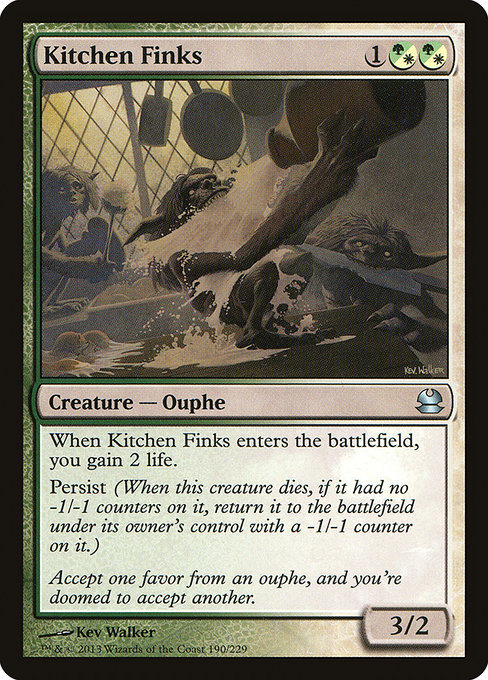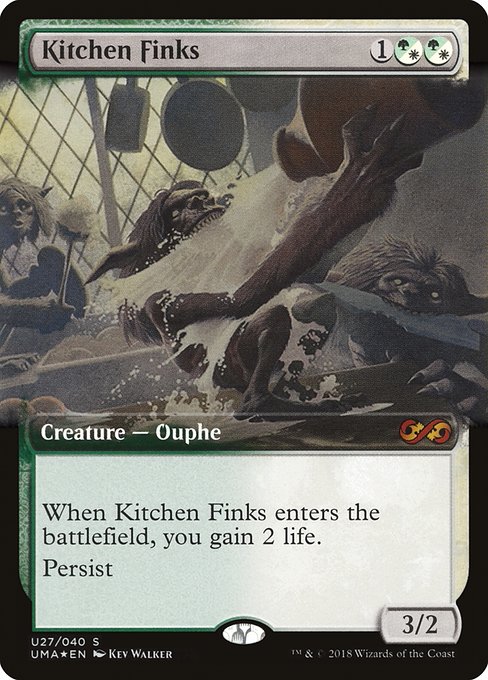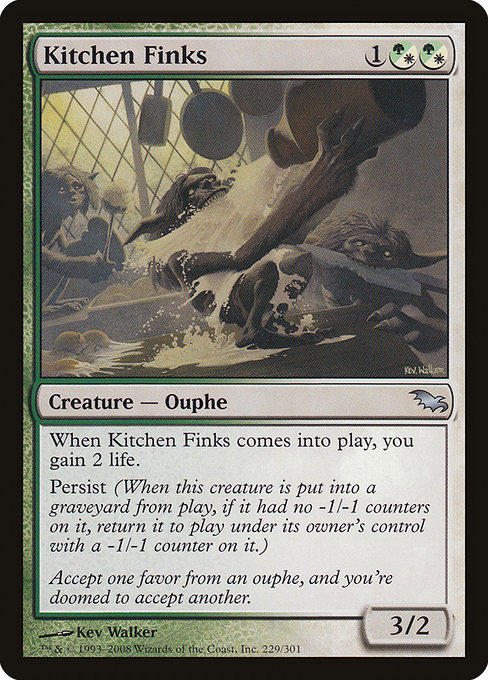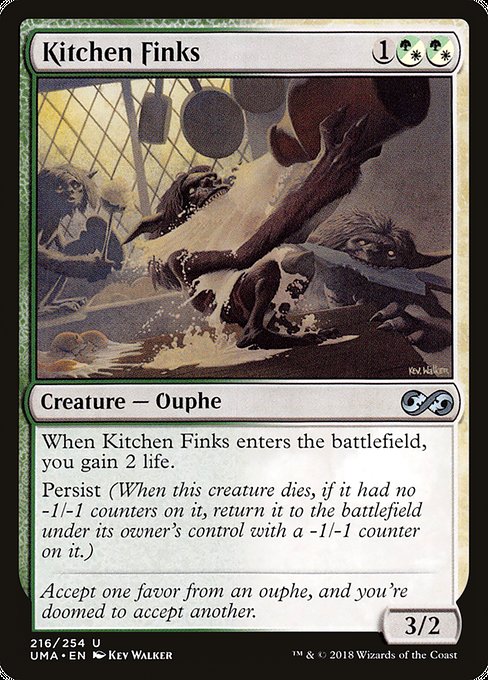Küchenhutzel
Kreatur — Buboh
Wenn die Küchenhutzel ins Spiel kommen, erhältst du 2 Lebenspunkte dazu.
Beharrlichkeit (Wenn diese Kreatur aus dem Spiel auf einen Friedhof gelegt wird und keine -1/-1-Marke auf ihr lag, bringe sie mit einer -1/-1-Marke unter der Kontrolle ihres Besitzers ins Spiel zurück.)
Beharrlichkeit (Wenn diese Kreatur aus dem Spiel auf einen Friedhof gelegt wird und keine -1/-1-Marke auf ihr lag, bringe sie mit einer -1/-1-Marke unter der Kontrolle ihres Besitzers ins Spiel zurück.)
3/2
standard
future
historic
gladiator
pioneer
explorer
modern
legacy
pauper
vintage
penny
commander
brawl
alchemy
paupercommander
duel
oldschool
premodern
Rulings
The persist ability triggers when the permanent is put into a graveyard. Its last known information (that is, how the creature last existed on the battlefield) is used to determine whether it had a -1/-1 counter on it.
When a permanent with persist returns to the battlefield, it’s a new object with no memory of or connection to its previous existence.
If a token with no -1/-1 counters on it has persist, the ability will trigger when the token is put into the graveyard. However, the token will cease to exist and can’t return to the battlefield.
If a permanent has multiple instances of persist, they’ll each trigger separately, but the redundant instances will have no effect. If one instance returns the card to the battlefield, the next to resolve will do nothing.
If a creature with persist stops being a creature, persist will still work.
If a creature with persist that has +1/+1 counters on it receives enough -1/-1 counters to cause it to be destroyed by lethal damage or put into its owner’s graveyard for having 0 or less toughness, persist won’t trigger and the card won’t return to the battlefield. That’s because persist checks the creature’s existence just before it leaves the battlefield, and it still has all those counters on it at that point.
If multiple creatures with persist are put into the graveyard at the same time (due to combat damage or a spell that destroys all creatures, for example), the active player (the player whose turn it is) puts all of their persist triggers on the stack in any order, then each other player in turn order does the same. The last trigger put on the stack is the first one that resolves. That means that in a two-player game, the nonactive player’s persist creatures will return to the battlefield first, then the active player’s persist creatures do the same. The creatures return to the battlefield one at a time.
When a permanent with persist returns to the battlefield, it’s a new object with no memory of or connection to its previous existence.
If a token with no -1/-1 counters on it has persist, the ability will trigger when the token is put into the graveyard. However, the token will cease to exist and can’t return to the battlefield.
If a permanent has multiple instances of persist, they’ll each trigger separately, but the redundant instances will have no effect. If one instance returns the card to the battlefield, the next to resolve will do nothing.
If a creature with persist stops being a creature, persist will still work.
If a creature with persist that has +1/+1 counters on it receives enough -1/-1 counters to cause it to be destroyed by lethal damage or put into its owner’s graveyard for having 0 or less toughness, persist won’t trigger and the card won’t return to the battlefield. That’s because persist checks the creature’s existence just before it leaves the battlefield, and it still has all those counters on it at that point.
If multiple creatures with persist are put into the graveyard at the same time (due to combat damage or a spell that destroys all creatures, for example), the active player (the player whose turn it is) puts all of their persist triggers on the stack in any order, then each other player in turn order does the same. The last trigger put on the stack is the first one that resolves. That means that in a two-player game, the nonactive player’s persist creatures will return to the battlefield first, then the active player’s persist creatures do the same. The creatures return to the battlefield one at a time.
Rulings
The persist ability triggers when the permanent is put into a graveyard. Its last known information (that is, how the creature last existed on the battlefield) is used to determine whether it had a -1/-1 counter on it.
When a permanent with persist returns to the battlefield, it’s a new object with no memory of or connection to its previous existence.
If a token with no -1/-1 counters on it has persist, the ability will trigger when the token is put into the graveyard. However, the token will cease to exist and can’t return to the battlefield.
If a permanent has multiple instances of persist, they’ll each trigger separately, but the redundant instances will have no effect. If one instance returns the card to the battlefield, the next to resolve will do nothing.
If a creature with persist stops being a creature, persist will still work.
If a creature with persist that has +1/+1 counters on it receives enough -1/-1 counters to cause it to be destroyed by lethal damage or put into its owner’s graveyard for having 0 or less toughness, persist won’t trigger and the card won’t return to the battlefield. That’s because persist checks the creature’s existence just before it leaves the battlefield, and it still has all those counters on it at that point.
If multiple creatures with persist are put into the graveyard at the same time (due to combat damage or a spell that destroys all creatures, for example), the active player (the player whose turn it is) puts all of their persist triggers on the stack in any order, then each other player in turn order does the same. The last trigger put on the stack is the first one that resolves. That means that in a two-player game, the nonactive player’s persist creatures will return to the battlefield first, then the active player’s persist creatures do the same. The creatures return to the battlefield one at a time.
When a permanent with persist returns to the battlefield, it’s a new object with no memory of or connection to its previous existence.
If a token with no -1/-1 counters on it has persist, the ability will trigger when the token is put into the graveyard. However, the token will cease to exist and can’t return to the battlefield.
If a permanent has multiple instances of persist, they’ll each trigger separately, but the redundant instances will have no effect. If one instance returns the card to the battlefield, the next to resolve will do nothing.
If a creature with persist stops being a creature, persist will still work.
If a creature with persist that has +1/+1 counters on it receives enough -1/-1 counters to cause it to be destroyed by lethal damage or put into its owner’s graveyard for having 0 or less toughness, persist won’t trigger and the card won’t return to the battlefield. That’s because persist checks the creature’s existence just before it leaves the battlefield, and it still has all those counters on it at that point.
If multiple creatures with persist are put into the graveyard at the same time (due to combat damage or a spell that destroys all creatures, for example), the active player (the player whose turn it is) puts all of their persist triggers on the stack in any order, then each other player in turn order does the same. The last trigger put on the stack is the first one that resolves. That means that in a two-player game, the nonactive player’s persist creatures will return to the battlefield first, then the active player’s persist creatures do the same. The creatures return to the battlefield one at a time.
Your collection? Your decks?
Want to manage your collection and/or create decks?


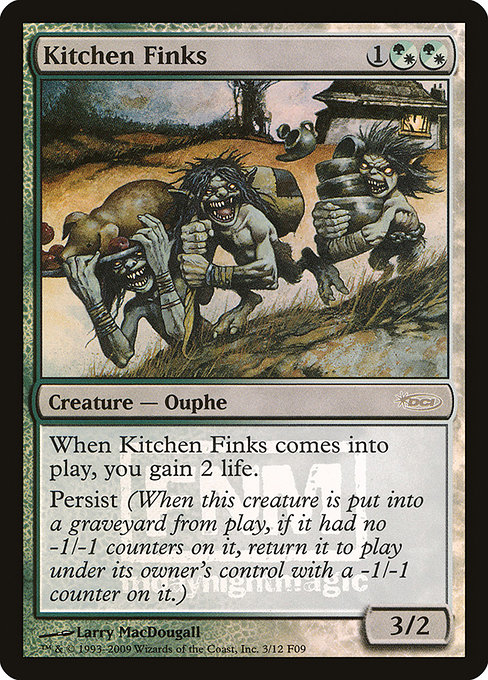
 0
0
 1.54€
1.54€
